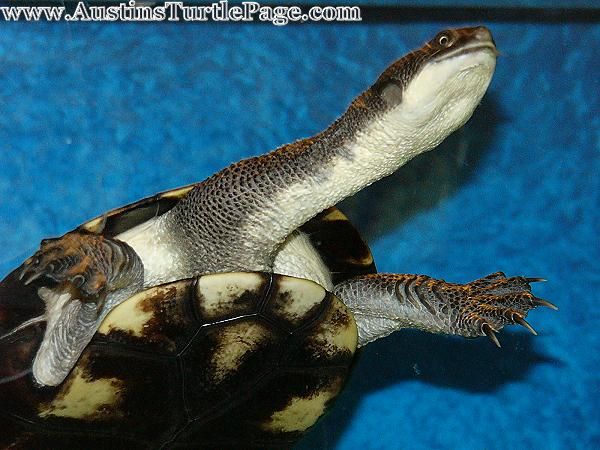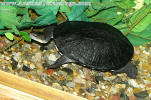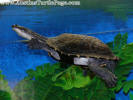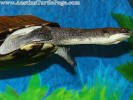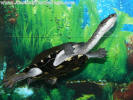|
|
|
|
||
|
Chelodina longicollis
|
||||
|
|
|
|
|
|
|
|
Carapace: This portion of the shell is oval, dark brown-to-black and is broadest at the back, past the center, with a smooth back edge. Down the center is a deep groove, extended from behind the head (about where we'd expect to find shoulders) almost to the tail (around the "waistline"). The scutes which are over the tail are raised and the lateral scutes are typically turned upwards. * Scott Thomson has shown that C. longicollis which have a brown carapace with clear growth rings is growing too fast. The carapace should be black. Plastron: The plastron is large and almost completely covers the shell's opening. It has a a deep notch in the back. The plastron, bridge and undersides of the carapace are cream to yellow in color with dark brown or black pigment bordering seams. This bordering can sometimes envelope the entire plastron, making it entirely black. Head: Relatively small and narrow, it becomes broader with age. The snout is slightly turned upwards and protruding. The skin of the head and neck is brown or dark gray on the top and sides, and is yellow to cream underneath. The skinny neck, about 60% the length of the carapace, is long and covered with small, pointy tubercles. Jaws are cream to yellow and the top jaw is not notched. Additional: Skin color is usually brown or dark gray on the top and cream colored underneath. Each leg has 4-5 large, transverse scales on the front part. Males also have a longer, thicker tail than females and have a concave plastron as adults. Size: Males cane reach around 10" while females can attain a carapace length of 12". |
||
|
|
|
|
|
|
|
|
Can be found in eastern Australia from just south of
Rockhampton in Queensland to Victoria.
|
||
|
|
|
|
|
|
|
||||
|
TEMPERATURE RANGE (°F)
It is important to understand that this is a cold climate turtle. In the wild it is active and feeding in water at 53° F. This turtle is very easy to overheat in captivity.
Scott Thomson says that he considers that this is one of the most difficult turtle species to keep, and that the often-recommended tropical setup of this species will eventually kill it. CAPTIVE DIET Variety is important. Long-necked Turtles are totally carnivorous. Never give food that is still frozen to the turtle. Commercial foods are available, such as Mazuri, ReptoMin or ZooMed. A 50/50 diet of whitebait and prawns (soaked for an hour to remove salt) is another option. Also add bloodworms, blackworms, garden worms, crickets, flies, moths and other insects to the diet. RECOMMENDED FEEDING SCHEDULE It is too easy to overfeed your turtle. The frequency of feeding should be 2 times a week and the amount roughly 5 to 10 bite size pieces per animal at each feed. This species of turtle prefers to eat in the water, however, Scott Thomson has had individuals that prefer to feed on the land. As they get older they require less food; feeding once per week is adequate. Give calcium and vitamin supplements weekly. CAPTIVE HABITAT C. longicollis are infrequent baskers, but do come out to bask, so a basking area is required. The habitat should be kept in cooler range as these turtles are cold climate animals. RECOMMENDED ENCLOSURE The turtles require a sizeable enclosure not only because of their size (females reaching 12"), but they are active turtles. When selecting a habitat for C. longicollis, keep not only carapace length in mind, but also neck length (up to 60% of the length of the carapace). While not recommended for indoor set-ups, adults can be housed in aquariums no smaller than 150 gallons for a single male and 175 gallons for a single female. Adding additional turtles to a habitat requires that you increase the size of the tank accordingly by half (ie; 1 male = 150 gallons, 2 males = 225 gallons, etc). Stock tanks also make great alternatives to glass an acrylic aquariums. WATER DEPTH Accomplished swimmers even as fresh hatchlings, C. longicollis enjoy deep water habitats. COMMUNITY HABITAT They do extremely well with other turtles from the same climate and are generally docile towards tankmates, although, as with any species, there are individuals who show aggression towards other turtles even when adequate room is provided. |
||||||
|
|
|
|
|
|
|
| This species is one of Australia's most terrestrial turtles, spending many months per year on land, the species has been observed feeding on land and the analysis of gut contents has found terrestrial insects. | ||
|
|
|
